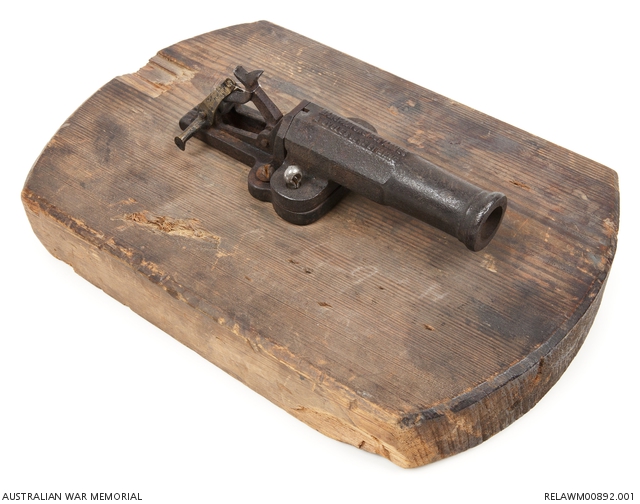| Place | Europe: France, Picardie, Somme, Amiens Harbonnieres Area, Harbonnieres |
|---|---|
| Accession Number | RELAWM00892.001 |
| Collection type | Technology |
| Object type | Firearm |
| Physical description | Steel, Wood |
| Maker |
Manufacture Fse D'Armes & Cycles de St Etienne Unknown |
| Place made | France |
| Date made | c 1913 |
| Conflict |
First World War, 1914-1918 |
French trip wire gun

Cast steel, 12 gauge (20 mm) bore gun with a sprung trigger mechanism designed to be attached to a trip wire. The barrel hinges to one side in front of the trigger mechanism to allow a pinfire 12-gauge cartridge to be inserted; there is a vertical slot at the back of the barrel to accomodate the pin. The following manufacturer's details are cast into the top of the barrel: 'MANAFACTURE FSE D’ARMES/ & CYCLES DE ST ETIENNE'. at the end of the item is cast the word 'DEPOSE' [removal].
The entire assembly is bolted to a block of wood approximately 300 mm x 200 mm x 35mm. Written in faded chalk on the wood near the gun is '49TH'.
French trip-wire gun used to give warning of any interference with wire entanglements and suchlike. A trip wire would have been attached to the hole in a simple spring-loaded trigger at the rear of the barrel. Originally designed in the 1880s as an anti-poaching device, these simple guns usually fired a 12-gauge pinfire cartridge to alert defenders to an impending intrusion. They originally cost from between 4 and 6 francs.
This example was made by an arms and cycle company at St Etienne in France. It was found near Harbonnieres by members of the 49th Battalion on 8 August 1918; the gun had apparently been captured by the Germans from the French.